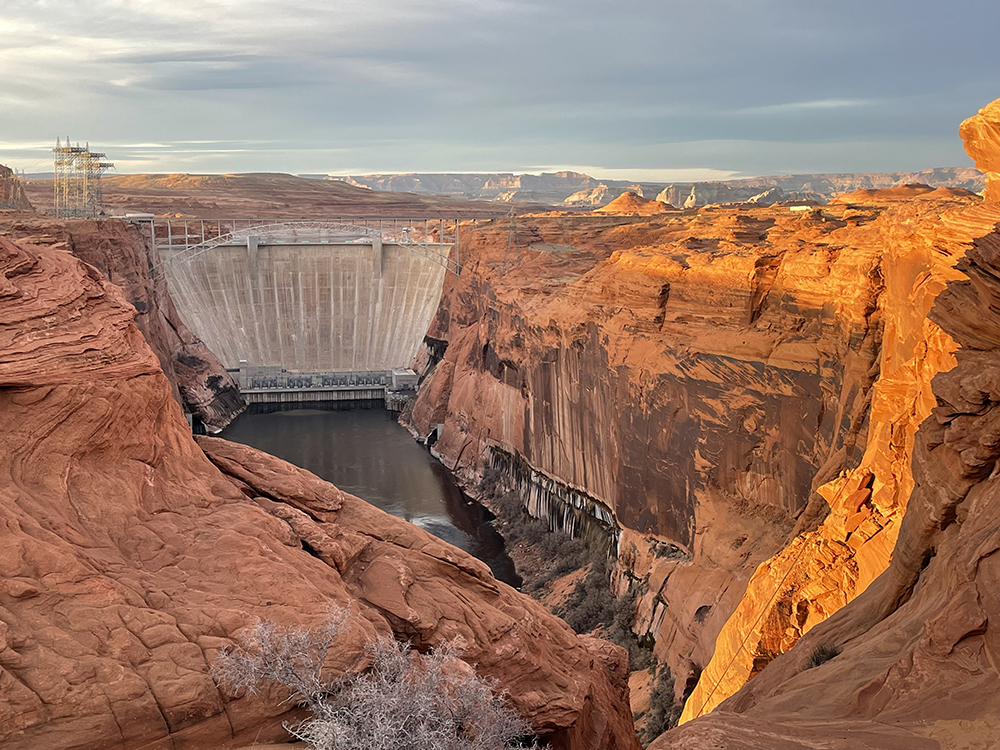Environmental process identifies and analyzes a range of releases from the dam to disrupt spawning of smallmouth bass; effort also considers revising protocol for high-flow experiments
 Downstream view of Glen Canyon Dam in Page, Arizona
Downstream view of Glen Canyon Dam in Page, Arizona
PAGE, Ariz. – The Bureau of Reclamation today released a draft Supplemental Environmental Impact Statement (SEIS) that analyzes varying the timing of water released from Glen Canyon Dam to disrupt the downstream establishment of nonnative fish, primarily smallmouth bass.
This document supplements the 2016 Glen Canyon Dam Long-Term Experimental and Management Plan (LTEMP) Final Environmental Impact Statement (FEIS) and Record of Decision. Glen Canyon Dam impounds Lake Powell, the largest storage unit of the Colorado River Storage Project.
The proposed updates to the 2016 LTEMP FEIS are in response to increasing numbers of warmwater predatory fish below Glen Canyon Dam, which can prey on native fish threatened under the Endangered Species Act. As Lake Powell’s elevation has declined, the epilimnion (the warmest, top-most layer of the reservoir), where these nonnative, warmwater predators reside, has become closer to the dam’s water intakes. As a result, warmwater predatory fish are more likely to pass through the dam into the Colorado River.
When water from this layer is discharged downstream, it increases the temperature of the river just below the dam, creating ideal spawning conditions for nonnative, warmwater fish that pose a threat to native species, including the federally threatened humpback chub.
A range of reservoir releases with varying combinations of temperature are analyzed in the draft SEIS to assess their effectiveness in disrupting and preventing further smallmouth bass spawning and survival.
“If these predatory, nonnative fish become fully established downstream of Glen Canyon Dam, they may threaten the great progress we have made in recovering the humpback chub,” said Reclamation Upper Colorado Basin Regional Director Wayne Pullan. “Because eradicating an established invasive species is expensive and extraordinarily difficult, it is important that we have these tools—this range of reservoir releases—analyzed in this SEIS available to us before the 2024 spawning season.”
High-Flow Experiments
The SEIS also includes potential modification of the protocol for conducting high-flow experiment (HFE) releases. The natural condition of the Colorado River, especially through the Grand Canyon, includes sandbars and beaches formed by river-transported sediment. Beaches and sandbars are important for recreation, habitat and protection of cultural resources. Because the river’s natural sediment drops out of the river in Lake Powell, the water released from Glen Canyon Dam is largely sediment-free. In order to build and maintain sandbars and beaches, the LTEMP includes HFEs to transport sediment in the river below the dam. The SEIS examines a broader window for assessing sediment available for beach-building which may facilitate more spring HFEs. HFE releases do not change annual volumes released from Glen Canyon Dam.
Background
Reclamation undertook an Environmental Assessment (EA) in August 2022. The draft EA, entitled Glen Canyon Dam/Smallmouth Bass Flow Options, was released for public comment on February 24, 2023. Based on the EA and the nearly 7,000 comments received, Reclamation concluded that additional analysis was warranted.
Since June 2023, Reclamation has been preparing an SEIS with input and coordination with federal agencies, states, tribes, cooperating agencies, stakeholders and other interested parties. The draft SEIS incorporates comments submitted during a public scoping period and the public comment period associated with the original EA.
Public Involvement
The draft LTEMP SEIS will be published in the Federal Register on Friday, Feb. 9, 2024, formally initiating the 45-day public comment period. Reclamation will host three virtual public meetings to provide information and answer questions. To register for a virtual meeting, submit written comments, or for more information, visit the project’s website: https://www.usbr.gov/uc/progact/amp/index.html.
The LTEMP draft SEIS involves the timing of hourly, daily, monthly and experimental releases from Glen Canyon Dam and not annual releases. Annual releases are determined by the 2007 Colorado River operating guidelines. These 2007 guidelines are being revised through their expiration at the end of 2026. A separate, ongoing post-2026 planning process will develop guidelines for when the current interim guidelines expire.


